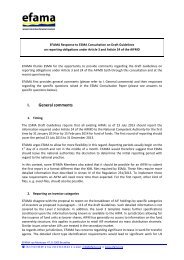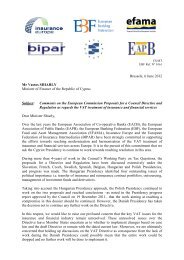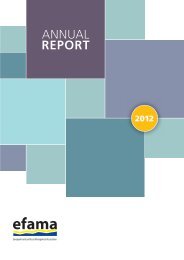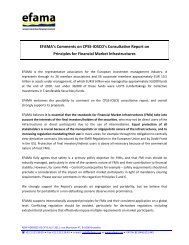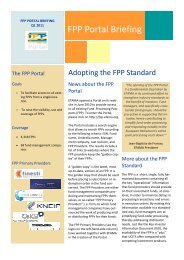EFAMA KPMG Solvency II Report
EFAMA KPMG Solvency II Report
EFAMA KPMG Solvency II Report
Create successful ePaper yourself
Turn your PDF publications into a flip-book with our unique Google optimized e-Paper software.
4.2.5 Data Quality<br />
4 WORKING GROUP FINDINGS | 37<br />
Requirements<br />
The <strong>Solvency</strong> <strong>II</strong> Directive requires insurers to provide accurate, complete and<br />
appropriate data to the regulator, regardless of whether the source of the data is<br />
internal or external to the insurer. Insurers will expect asset managers to provide<br />
them with data that complies with these requirements, together with some form of<br />
assurance over the quality of the data.<br />
Challenges and Impacts<br />
The requirements pose several challenges for asset managers:<br />
• Materiality: Insurers need only to provide to the regulator data which are material<br />
to their business, and only material data needs to be quality assured. The principle<br />
of materiality must be applied to determine the criticality and risk that a certain set<br />
of data presents to an insurer in order to define the quality<br />
standards to be applied.<br />
However, the asset managers cannot know which data are material for which insurer,<br />
and therefore must be ready to quality assure all of the data it provides to insurers.<br />
• Data quality scope: Asset managers and TPAs already perform a number of quality<br />
controls and checks on the data that are currently provided to insurers. <strong>Solvency</strong> <strong>II</strong><br />
implies a large increase in data that the insurer needs to report to the regulator and,<br />
consequently, a large increase in the data that asset manager will have to deliver to<br />
the insurer. A gap analysis and subsequent process review should be performed to<br />
assess the impact that this will have on current data management activity.<br />
The gap analysis needs to consider the changing nature of some key data sets<br />
that the asset manager currently supplies. For example, where an asset manager<br />
currently provides an insurer with a single credit rating (e.g. a Standard & Poors<br />
rating) and the direct legal issuer of a certain instrument, the insurer may now require<br />
multiple credit ratings and ultimate parent information for <strong>Solvency</strong> <strong>II</strong> reporting.<br />
•Timing conflicts: Insurers need to process large volumes<br />
of data from different<br />
internal and external providers within very short deadlines to report to the regulator.<br />
This will increase the pressure on the asset manager to deliver holdings data and<br />
enriched data to the insurer very early after the quarter end (for regulatory reporting)<br />
or even after the month end (for monitoring purposes). This is generally expected to<br />
be by business day three after every month or quarter end.<br />
T here is an obvious conflict between<br />
being required to provide data sooner in the<br />
monthly cycle but at the same time needing more time to check that the data has<br />
suffi cient quality for <strong>Solvency</strong> <strong>II</strong> purposes.<br />
Further regulatory conflict may<br />
also arise from the fact that insurers will now demand<br />
information earlier than other types of institutional or private investors.<br />
© 2012 <strong>KPMG</strong> LLP, a UK limited liability partnership, is a subsidiary of <strong>KPMG</strong> Europe LLP and a member fi rm of the <strong>KPMG</strong> network of independent member fi rms affi liated with <strong>KPMG</strong> International<br />
Cooperative, a Swiss entity. All rights reserved.





